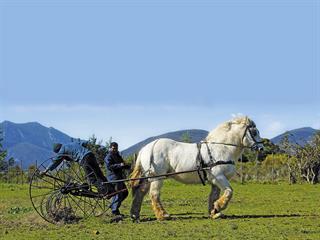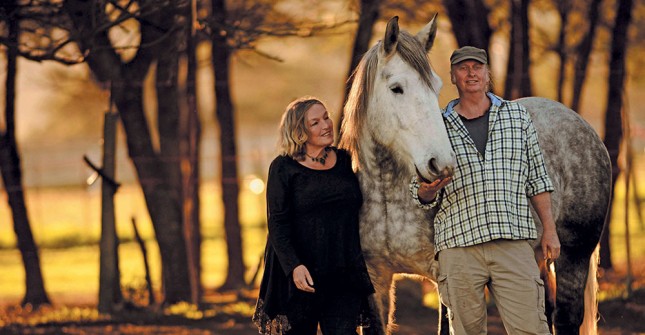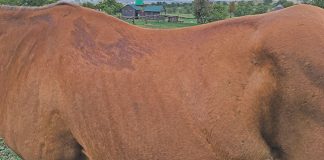
Peter and Christine Watt have been breeding Percherons since 2002, and there are currently 21 of these heavy draught horses on their farm, with 35 horses in total.
According to Christine, it is difficult to make money keeping horses, as they are expensive to feed and maintain. “It’s lunatic passion that drives us, and vet bills alone can be crippling,” she says. Tourist accommodation, Percheron cart rides and an on-site restaurant supplement the farm’s income.
Outeniqua Moon Percheron is a stud herd registered with the Percheron Horse Breeders’ Society of Namibia. Well-bred Percherons must be big, says Christine. The minimum standard for the society is 15,3 hands high (hh), or 1,6m, for mares and 16hh (1,63m) for stallions.
Most of the Percherons on the Watts’ farm are considerably bigger than this: the mares start at 16,2hh (1,68m) and the stallions start at 17hh (1,73m).
Shadowfax is currently the largest Percheron in South Africa at 18,3hh (1,86m). He is only four years old and will stop growing at age seven.

Breeding
In-hand covers are the norm at Outeniqua Moon; this protects stallions from being kicked and ensures that both mare and stallion are clean.
“The stallion can introduce bacteria into the uterus, which will cause the foal to be lost to pneumonia, for example,” explains Christine. “We tease the stallion just before he covers the mare and hose down his erect penis to remove any bacteria.”
Disinfectant should never be used, as it can kill the sperm. “Then we wash the mare’s vagina and bandage her tail to keep it out of the way. We never use a twitch, but position her between poles and hold a thick rope around her back legs so that she doesn’t kick the stallion.”
Twitching can cause stress, which reduces the chance of conception. “Once he has mounted her, we drop the rope and let him do his job,” says Christine. Mares come into season every 21 days, but ovulate in spring and summer, although this can be manipulated. Stallions are active all year round.
Human assistance is necessary during foaling. “If the foal doesn’t get onto the teats within four hours and get colostrum, it’ll suffer or die,” explains Christine.
“There are many mortalities during foaling with Percherons because the foals are big, and they also need to learn to bend and twist in order to feed. If you are on hand, you can also milk the mare and give the foal a bottle until it’s strong enough to bend and twist to feed itself.”
Another problem is ‘dummy foal syndrome’. This occurs either because the foal is starved of oxygen in the birth canal (due to its size) or it does not suckle well. “They’ll die if there’s nobody there to help them,” says Christine. She and Peter do night vigils with mares and newborn foals to ensure there are no problems.
Guarding against biliary is essential; if the mare loses the foal due to biliary there can be many complications. Laminitis can result from prostaglandin being released from losing the foal. “We try very hard to keep the mares pregnant once they have conceived,” says Christine.
Correct feeding
Foals are weaned at six months to prevent exhausting the mares. Mares are kept in good condition and are never allowed to become ‘ribby’, as milk quality will suffer and the foal will not develop well.
Incorrect feeding is usually the reason Percherons fail to reach optimal size, according to Christine. “Most pasture in South Africa is sourveld grasses which have minimal nutrition value,” she says. “Unless you have exceptional pasture of good mixed grasses suitable for horses, supplementary feed is essential.
“It’s also better for horses to live outside, providing the weather is good enough. When the temperature is below zero, it’s advisable to provide stabling. But stabling brings with it problems of colic, crib biting, depression, and stomach ulcers, so if it’s not necessary to stable, don’t.”
Lucerne is the optimal food for Percherons, explains Christine, as it is low in sugar and high in protein and calcium to build muscle – and Percherons need plenty of muscle.
Outeniqua Moon Percherons are also given the vitamin supplement Equivita and lucerne pellets as a concentrate. Extra biotin is given to foals. The correct ratio of calcium to phosphorus is essential for strong bones. “We wet our feed to prevent colic, which, along with African horse sickness and biliary, is the biggest killer of horses,” says Christine.
“Dry pellets suck all the moisture from the horse’s stomach and can cause a blockage, which means that you could lose a horse.” Growing youngsters are fed three times a day along with milking mares. The other mares are fed twice daily.
“Percherons don’t need too much to maintain their condition, but once they lose condition it’s very difficult to get them back into shape again because you have to rebuild muscle that has been lost.”
Colours, prices and temperament
Percherons are born black and then usually turn grey. Black adult Percherons are more unusual but don’t command higher prices. Buyers look for size and temperament rather than colour. The horse must be calm, friendly and hard-working.
“Never beat a Percheron because you’ll make him aggressive and destroy the horse,” says Christine.
Horses are sold only to known buyers. “We’re not hard-nosed business people. We’re passionate about Percherons and the horses come first,” she explains.
They have no plans for expanding their business currently as running costs are extremely high – and Percherons are “definitely not money spinners,” she adds. “People should roll out the red carpet for horses, because without the heavy draught horse there wouldn’t have been an industrial revolution,” says Christine.
Email Outeniqua Moon at [email protected]. Visit www.outeniquamoon.co.za.













